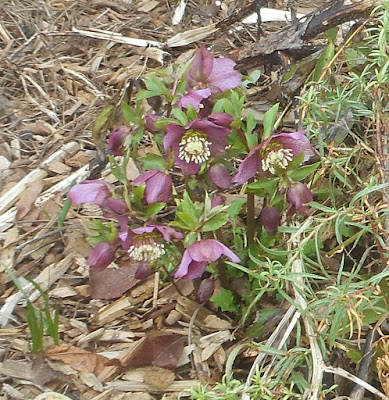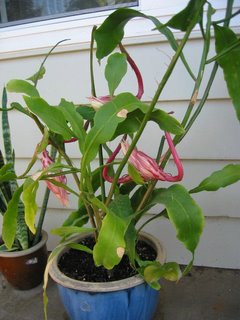
More accurately, it is an
Epiphyllum oxypetallum, jungle-dwelling cacti that live on tree branches and rocky outcrops far above the forest floor.
This cactus was started from a cutting, given to me by a friend. Her mother brought it to the US from Hong Kong when she emigrated. The only name that she knew was "Chinese cactus", although in reality, it's not Chinese. They originate in Mexico, central America, and Brazil. The exact origin is uncertain. They have naturalized in South Asia and Southeast Asia. This species blooms once annually. The flowers open once, during the night, then whither in the early morning and die. Their extravagant, sensual appearance, and ephemeral character, are symbolic of how beautiful, and brief, life can be.
They are grown in southern China, where they are known as Tuan Hua.
Here is an article about a neighborhood in Taipei, gathering to watch one open. There it is known as "Tan Hua Yi Xian" (A Flower That Vanishes as Soon as It Appears)
I've brought it inside each winter, and leave in on the North side of the house each summer. Last year it had only 2 blossoms. The year before, it hnad a fungal infection and most of it died. This Spring I transferred it to a larger pot. The growth medium is Miracle Grow potting soil. It's growing nicely. Not a compact plant, it takes a lot of room. Fortunately, we have the space. It's easy to grow from cuttings. One small section broke off this summer. I kept walking past it thinking, "Maybe I should pot that up". Finally, feeling sorry for it after 2 or 3 weeks, I did. After 3 weeks, that section is now growing and has added a new leaf-pad, larger than the original cutting.
In South Asia and Malasia this flower is known as the Bunga Bakawali. The blossom is supposedly controlled by a night spirit, but this must be a
fairly obscure legend, I could only find hints of it in a
google search. I a reader of this blog knows more, I would love to hear the story.
For members of the diaspora from Southern China and Southeast Asia, the Bunga Bakawali can be a
living reminder of their origin. "It was when she said that I understood everything. This flower reminded her of that distant childhood she once had, the innocent little child she once was, and most importantly, the people she truly misses, her mother, her sisters"

At 5pm, the "Dutchman's pipe" stage. The buds are starting to swell.

At 830pm. Even at this stage, they are quite beautiful.

Fully open at 10pm. This year the fragrance fills the night sky. It's raining, but this plant is in a sheltered location away from the rain.

Also at 10pm. This doesn't quite match the legend of opening exactly at midnight, but it will be open then as well. It may be confused by the time zone, of course.

8am. Having had their moment in the night, the blossoms close again. Three did not open last night, so will be expected to open tonight. That doesn't quite match the one-night-per-year legend either, but close enough.








































